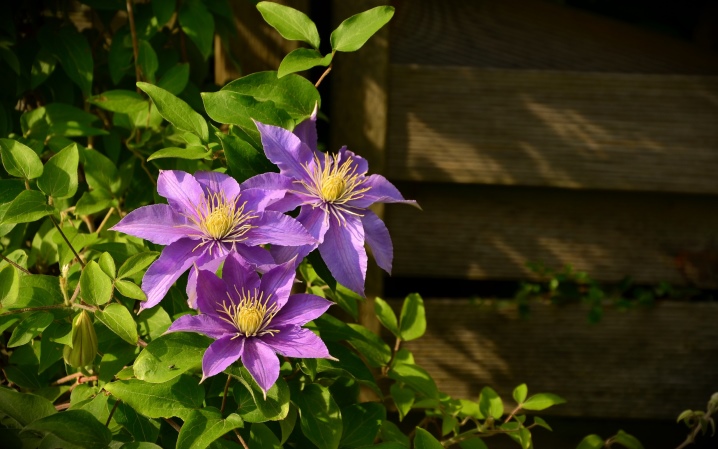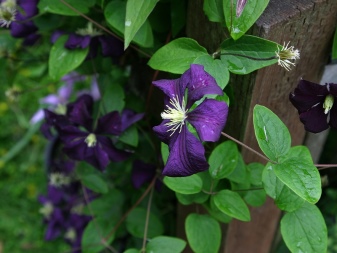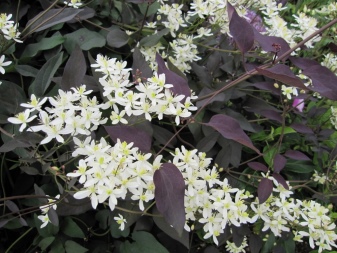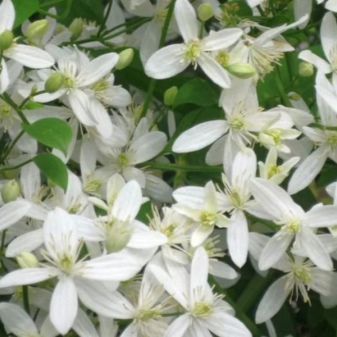Description of Clematis Niobe
Clematis varieties Niobe are climbing vines that require support for which they cling to leaf stalks, reaching a height of 2.5 - 3 m. The growth force of young shoots is moderate.
Large-flowered variety, the buds of which bloom from the second decade of May to the third decade of June. Second wave: from late June to early July and bloom until late September. Flowering occurs in two waves, on last year's and young shoots, while not completely losing their bright color. Dissolving, the buds of clematis Niobe acquire a black and burgundy color, gradually changing shades, becomes ruby red, with velvety shiny petals. The diameter of the blossoming Niobe is 15 cm, the flower consists of 6-8 bright, pointed sepals, which are wide at the base and taper towards the end. The stamens and pistils are bright yellow. Clematis of the Niobe variety begins to bloom profusely at 3-4 years old, in the first 2 years a small number of flowers are tied.
The fruit is a multi-root with numerous seeds, pinnately pubescent of medium size.
Leaves are complex-trifoliate, pointed, edges are solid dark green above, light green below with well-defined veins.
The root is strong, fibrous, deeply penetrating into the ground.
Frost resistance, drought resistance
Clematis Niobe is a frost-resistant variety suitable for cultivation in zones 3b, 4-11. The root system can withstand up to - 35 ° C, which allows growing in most of the territory of Russia, especially in the middle lane, and it is also possible to grow in Siberia.
Clematis of the Niobe variety is adapted for cultivation in arid regions, with more or less moist soil, but not in excess. For a long time, it can do without watering, but in hot weather with strong winds, when the soil begins to crack, it requires soil moisture.
Disease and pest resistance
Clematis Niobe does not differ from other varieties with strong immunity to diseases and pests. It is also susceptible to fungal diseases, especially if the agricultural practices of planting and growing are violated.
Often clematis is exposed to diseases:
- wilt (wilting);
- rust;
- root rot;
- ascochitis (leaf spot);
- gray rot;
- powdery mildew;
- alternaria;
- mosaic;
- necrosis;
- cylindrosporiasis.
It is very important to follow the rules of care and cultivation for clematis Niobe, as well as to carry out preventive measures, spray in the spring and autumn with preparations with a fungicidal effect or shed them the soil. Diseased shoots must be immediately removed and burned so that re-infection does not occur.
Pests that most often appear on clematis of the Niobe variety:
- aphid;
- bear;
- small rodents;
- nematodes;
- butterflies and moths;
- spider mite;
- snails and slugs.
To eliminate parasites and insects, bait should be laid out on the site or repelling devices should be installed near the bushes. And also do not flood the soil around clematis, make drainage grooves so that the waterlogged soil does not attract pests. In spring and autumn, after spraying against diseases, treat clematis and the soil next to it with preparations with an insecticidal effect.
Video
We offer to additionally watch videos in which experts share their opinions about this type of clematis:
Graduated from MGRI them. Ordzhonikidze. His main specialty is a mining engineer-geophysicist, which means a person with an analytical mindset and various interests. I have my own house in the village (respectively, experience in truck farming, gardening, mushroom growing, as well as fiddling with pets and poultry). Freelancer, perfectionist and "bore" in relation to his duties. Hand-made lover, creator of exclusive jewelry made of stones and beads. A passionate admirer of the printed word and an anxious observer of everything that lives and breathes.
Found a bug? Select the text with the mouse and click:
Natural toxins are found in many plants; those that are grown in gardens and orchards are no exception. So, in the seeds of apples, apricots, peaches there is hydrocyanic (hydrocyanic) acid, and in the tops and peel of unripe nightshades (potatoes, eggplants, tomatoes) - solanine. But do not be afraid: their number is too small.
It is believed that some vegetables and fruits (cucumbers, stalk celery, all varieties of cabbage, peppers, apples) have a "negative calorie content", that is, digesting more calories than they contain. In fact, the digestive process uses only 10-20% of the calories from food.
Humus - rotted manure or bird droppings. It is prepared like this: manure is piled in a heap or pile, sandwiched with sawdust, peat and garden soil. The collar is covered with a film to stabilize the temperature and humidity (this is necessary to increase the activity of microorganisms). The fertilizer "ripens" within 2-5 years - depending on external conditions and the composition of the feedstock. The output is a loose homogeneous mass with a pleasant smell of fresh earth.
The homeland of pepper is America, but the main breeding work on the breeding of sweet varieties was carried out, in particular, by Ferenc Horvat (Hungary) in the 1920s. XX century in Europe, mainly in the Balkans. Pepper came to Russia from Bulgaria, therefore it got its usual name - "Bulgarian".
In small Denmark, any piece of land is a very expensive pleasure. Therefore, local gardeners have adapted to growing fresh vegetables in buckets, large bags, foam boxes filled with a special earthen mixture. Such agrotechnical methods allow you to get a harvest even at home.
Oklahoma farmer Carl Burns has developed an unusual variety of colorful corn called Rainbow Corn. The grains on each ear are of different colors and shades: brown, pink, purple, blue, green, etc. This result was achieved through many years of selection of the most colored common varieties and their crossing.
A novelty of American developers is the Tertill robot, which weeds in the garden. The device was invented under the guidance of John Downes (the creator of the robot vacuum cleaner) and works autonomously in all weather conditions, moving on uneven surfaces on wheels. In doing so, he cuts all plants below 3 cm with the built-in trimmer.
In Australia, scientists have begun experiments to clone several grape varieties from colder regions. Climate warming, which is predicted for the next 50 years, will lead to their disappearance. Australian varieties have excellent characteristics for winemaking and are not susceptible to diseases common in Europe and America.
One of the most convenient methods to prepare a grown crop of vegetables, fruits and berries is freezing. Some people believe that freezing leads to a loss of the nutritional and beneficial properties of plant foods. As a result of the research, scientists have found that there is practically no decrease in nutritional value when frozen.
For what reasons does clematis not bloom?
The plant does not always please its owners with the flowering. A picture is often observed when the bush reaches a large size, the vine is covered with juicy leaves, and there are no buds.
Sometimes, for some unknown reason, the bush does not bloom again or blooms in small white inflorescences
Florists are not counting on such results at all, respectively, it is important to find out the cause, eliminate it and achieve the desired result
The reason that the plant does not emit buds is explained as follows:
the seedling is planted without taking into account the preferences of the plant;
care is not given due attention;
the vine is affected by a pest or some kind of disease;
not a healthy seedling was purchased;
the plant was not protected from frost;
liana is not fed with fertilizers.
Saplings love rich, loose soil. After planting in a fertile environment, feeding is carried out after two years. If this rule is ignored, the plant stops blooming or the moment the buds appear does not come.
Good to know! Poor soil can gradually lead to poor flowering. If all the requirements for care are taken into account, and the plant does not differ in a healthy appearance, the reason may be that the root system has reached groundwater, which is highly undesirable.
Landing rules
Planting clematis "Niobe" can be carried out both in the spring and autumn months. The exact dates are determined depending on the climatic zone and the frost situation. The most successful periods for planting rhizomes are called the days from the second half of April to the end of May, as well as the period from September to the first weeks of October. It is better to place the plant in a sunny area or in the presence of partial shade. Experts recommend focusing on the following sides: southern, southeastern, southwestern
The absence of drafts is important, as well as the presence of a meter or two meters distance from buildings and massive fences.
In general, clematis makes standard requirements for the state of the soil: loose, well-drained, with neutral acidity. Loam or sandy loam soil is most suitable. Seedlings are required of high quality, they should not be damaged or dry roots. If possible, plants with a closed root system should be purchased from the nursery.
In addition to the rhizomes, the aerial part should also be examined: shoots with leaves should be elastic, rich green and healthy. Immediately before planting, the rhizomes are removed for half an hour in a solution of potassium permanganate or phytosporin, that is, a substance responsible for disinfection. It is also worth watering the earth with them, and immediately remove the spoiled roots. The hole is dug out of such a size that the depth varies from 60 to 70 centimeters, and the width is in the range from 40 to 50 centimeters. The bottom of the pit must be filled with drainage material, for example, small stones and sand.
The soil extracted from the pit is mixed with grass or rotted manure and immediately enriched with peat, turf and ash. As a support for the vine, a structure made of wood or metal is installed in the pit. An enriched soil mixture is laid on top of the drainage, and then the seedlings are carefully deepened.
Description
Shrub clematis (another popular name is clematis) are unpretentious flowering perennials, the height of which can vary from 0.5 to 2 meters. Most varieties of these plants delight with flowering for several months - from about the beginning or middle of summer until late autumn.
Among gardeners, bush clematis are especially popular, which they are provided with amazing unpretentiousness, endurance, frost resistance. These features allow plants to take root even in regions with a harsh climate, including the Urals and Siberia.

The color palette is quite extensive, including milky white, lilac, purple, lemon yellow and even burgundy brown shades.
The root system of these perennial shrubs can be pivotal or fibrous. The color of the leaves in most varieties is juicy green. However, there are also clematis with purple-burgundy leaves.


Experienced growers divide all varieties of bush clematis into 2 large categories:
- large-flowered;
- small-flowered.
The first category includes solid-leaved clematis, in which flower sizes can reach 10-12 centimeters. In some hybrid plants, flower sizes can reach 20-25 centimeters. The second category includes clematis with small flowers, whose size does not exceed 3-4 centimeters.


The reasons why the growth of clematis is slowing down.
So, what can cause disturbances during the growing season and slow down the growth of clematis?
1. Incorrectly adjusted irrigation regime. Clematis is extremely moisture-loving, the soil in the near-stem circle of the plant should get wet to a depth of 50-70 cm when watering.After you have planted the plant in a new place, it should be watered at least once a week (in dry weather, twice a week) ... After about two months, when the plant is completely rooted, the interval between waterings can be increased to ten days (again, based on the weather and rainfall). Mulching the soil after watering will keep it moist longer.
2. The quality and composition of the soil. If the soil is too dense, it will make it difficult for water and air to reach the roots, and therefore slow down the growth of the plant. This is not to say that clematis are especially demanding on the composition of the soil, but like any other plant, they grow best on loose and nutritious soil. This should be taken care of when planting by preparing a nutrient mixture of compost, sand and earth from your site. Alternatively, you can buy clematis primer from a garden center or flower shop.
3. Insufficient fertilization can also delay the development of clematis. From spring to September, regular feeding should be carried out, providing the plant with everything necessary for flowering and growth.
4. Sometimes the development of a plant can be delayed by untimely pruning, therefore it is necessary to carry out sanitary or cosmetic procedures at the proper time.
5. Frost can be another reason for stunted growth. All clematis are thermophilic and do not tolerate winter well, they all need high-quality shelter from frost. Therefore, if you want to keep the plant healthy, then you need to carefully cover it before freezing.
6. If the plant is sick or affected by harmful insects, then it also slows down or stops growth. Regularly inspect clematis and at the first symptoms of illness or the appearance of insects, treat the crown of the plant with special preparations.


